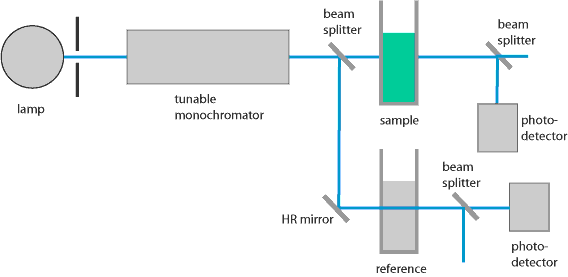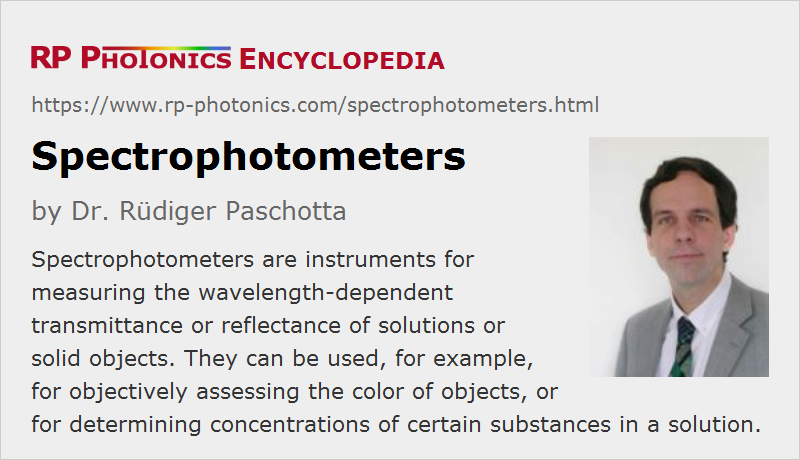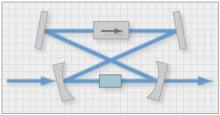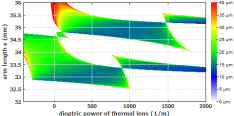Spectrophotometers
Definition: instruments for measuring the wavelength-dependent transmittance or reflectance of solutions or solid objects
More general terms: spectrometers, optical metrology instruments
German: Spektrophotometer
Categories: general optics, optical metrology
How to cite the article; suggest additional literature
Author: Dr. Rüdiger Paschotta
Spectrophotometers are instruments for measuring wavelength-dependent optical properties such as transmittance or reflectance of solutions or solid objects. Such devices are also often called spectrometers, but the term spectrophotometers is more specific and precise. Note that a measurement with such an instruments does not deliver an optical spectrum (optical intensity vs. wavelength), but rather a wavelength-dependent quantity of a specimen under test.
Spectrophotometers are available for different spectral regions:
- Some instruments are usable only in the visible spectral region (VIS), e.g. for colorimetry.
- Others are suitable only for the ultraviolet region (UV), or in addition for visible light (UV VIS).
- Some devices are made for infrared light (IR), or for the near infrared (NIR) only.
- Some UV VIS IR spectrophotometers cover all spectral regions.
Typically measured quantities are wavelength-dependent transmittance, absorbance or reflectance. In some cases, the amount of scattered light can be measured.
Spectrophotometers are often laboratory instruments put on some table, but there are also hand-held instruments. For colorimetry, one can often simplified colorimeters, using only three (or a few more) color channels, if the purpose is only measuring colors.
Operation Principles
Scanning Spectrophotometers
The basic operation principle of most spectrophotometers is to illuminate the object under investigation with quasi-monochromatic light of a variable wavelength and measure an optical property such as reflectance, absorbance or the degree of light scattering as a function of wavelength. Such instruments are called scanning spectrophotometers, since their operation involves scanning through spectral regions.
In most cases, a spectrophotometer contains a broadband light source (white light source), for example an incandescent lamp or a high-pressure gas discharge lamp, followed by a tunable monochromator – for example, a Czerny–Turner monochromator based on a diffraction grating. After the monochromator, one has a relatively faint light beam with a beam radius of typically a few millimeters and a moderate divergence (but substantially more than for a laser beam with the same beam radius), which can be sent through (or to) a sample.

At any time, only a small part of the total generated optical power can be used for the measurement. A first reason for that is that the used lamp emits in all directions, and one can utilize only light radiated in a certain small range of directions. Further, only a small part of the spectrum is used at a time. Particularly when a high spectral resolution is required, one may then require a long measurement time per wavelength interval for obtaining a sufficiently high signal-to-noise ratio, and the overall measurement time can be rather long. It is certainly helpful to use a kind of photodetector which can be highly sensitive and fast at the same time – for example, a photomultiplier.
Alternatively, one may use some kind of tunable laser, which can provide a spectral brightness which is orders of magnitude higher. The measurement times can then be dramatically reduced. However, tunable lasers are much more limited in terms of spectral range, also far more expensive and more difficult to use. Therefore, most spectrophotometers still rely on broadband light sources and monochromators.
An intermediate solution can be to use a supercontinuum source, which exhibits a high degree of spatial coherence and can thus also offer a substantially increased signal level and corresponding reduction of measurement time. Such sources can cover wider spectral ranges than tunable lasers.
Usually, the obtained intensity (more precisely: optical power) after the monochromator undergoes substantial changes while scanning through different wavelengths, and it may in addition exhibit temporal drifts, for example due to temperature changes or aging of the used lamp. Further, the responsivity of the photodetector will usually be wavelength-dependent. For those reasons, accurate measurements of absorbance or reflectance, for example, require the comparison of intensities with or without the object under investigation.
In a single beam spectrophotometer, one does the calibration with a separate calibration scan, where no sample or a reference sample is inserted. Depending on the required accuracy, calibration scans may be necessary quite often or only once per day, for example.

Better accuracy and higher convenience is obtained when simultaneously doing both measurements. A common solution is to use a dual-beam setup (see Figure 2). Here, the monochromatic light beam is split into two beams, using a beam splitter. One of the beams is transmitted through the sample to a photodetector; the other one directly gets to another photodetector, or is transmitted through a reference sample. A challenge may be that the beam splitting ratio can hardly be wavelength-independent over a very large spectral range. That can be solved, for example, by using two or three such beam splitters such that each of the beams is reflected at one such beam splitter and transmitted at another one, having the same optical properties.
Instead of two different detectors for sample and reference, one may use a single photodetector which alternately receives light from the sample or from the reference arm, e.g. through some kind of chopper with rotating discs. This also eliminates effects of any differences between two detectors.
Even with a dual-beam spectrophotometer (or double beam instrument), one may sometimes need to do a calibration scan where the sample is replaced with a reference sample. Only that way one can make sure that the measurements are not affected by any asymmetries in the setup, for example resulting from dust, dirt or misalignment.
For accurate measurements, the properties of the investigated objects should of course be approximately constant within the time required for scanning. This may be a problem, for example, when monitoring chemical reactions occurring with a substantial speed.
Non-scanning Spectrophotometers
The basic principle of a non-scanning spectrophotometer is to illuminate the object with broadband light and do the spectral analysis on the photodetector side. That way, it is possible to measure properties at all relevant wavelengths simultaneously, and the measurement can be correspondingly faster, assuming that spectral analysis does not take much time.
The used spectrometer for analyzing light coming from the object may be of the usual Czerny–Turner type. This approach is quite appropriate when analyzing transmitted or reflected light, where the analyzed light can easily be directed to the input slit of the spectrometer, but less for light scattered in a wide range of directions, particularly when the scattering efficiency also depends on wavelength.
Spectral analysis can also be done with a Fourier transform spectrometer; this technique is often used for measurements in the infrared spectral region, and is then called Fourier-transform infrared spectroscopy (FTIR). For more information on the measurement principle also see the article on white light interferometers.
Just as far as scanning spectrophotometer, the wavelength-dependent source intensity (non-flat source spectrum) must be taken into account. Frequently, one just compares measurements with and without a sample, or with a sample and a reference sample. There are also instruments containing two spectrometers, one for the sample light and one for the reference beam.
Spectrophotometers for Fixed Wavelengths
There are also spectrophotometers which do measurements only on some limited number of fixed wavelengths, which are set for a specific application.
Performance Figures of Spectrophotometers
The most importance performance characteristics of such instruments are:
- the quantities which can be measured (e.g. absorbance only, or absorbance and reflectance)
- the accessible spectral range, ideally UV - VIS - IR
- the spectral resolution (fixed or variable, often limited by a monochromator)
- the absorbance range (limited by the light source and the detector sensitivity)
- the measurement time for a given spectral range and resolution
Examples for Applications of Spectrophotometers
Colorimetry
In some applications, the purpose is to objectively assess the color of certain objects, for example printed materials or textiles. This is sometimes necessary, because the assessment of colors by the human eye is subject to various disturbing influences, such as different ambient light conditions, different colors of neighbored objects and perception differences between different persons. In contrast, a spectrophotometer can deliver objective data which are not subject to such influences.
There are also colorimetric applications in industrial processes. In particular, quality control can depend on color properties, because colors are often correlated with other properties of interest.
Spectrophotometers which are optimized for colorimetry are also called colorimeters. They normally work with visible light only, or possibly also with near-ultraviolet and near-infrared light.
Characterization of Laser Mirrors
Laser mirrors are often characterized in terms of reflection spectra, which also contain useful information concerning transmission regions for pump injection, output coupling and for the suppression of unwanted laser lines.
If the used spectrophotometer is not directly suited for measuring under some non-normal incidence, one may have to use an additional highly reflecting mirror (e.g. broadband metal-coated first surface mirrors) in addition, effectively measuring a double reflection on the mirror under test.
Identification of Substances
Based on characteristic spectral absorption features of various substances, it is possible to identify a wide range of substances e.g. in a liquid solution or in a gas cell based on broadband absorption spectra.
Concentration Measurements
The absorbance of a solution often depends on the concentration of certain absorbing substances. Therefore, such concentrations can be calculated from measured absorbance values. This is particularly simple if the absorption lines of different occurring substances do not overlap; one may simply use Beer–Lambert law. In more complicated cases, with overlapping absorption features, it is still often possible to accurately calculate the contributions of different substances to the total absorbance from the recorded absorption spectrum.
Such measurements can be done in different spectral regions, frequently in the infrared.
Monitoring of Agriculture Products
Specialized spectrophotometers are used for monitoring the status of agricultural products. For example, they can be used to determine how far a ripening or baking process has advanced, and give an alarm if certain parameters are out of the allowed ranges.
Suppliers
The RP Photonics Buyer's Guide contains 16 suppliers for spectrophotometers.
Questions and Comments from Users
Here you can submit questions and comments. As far as they get accepted by the author, they will appear above this paragraph together with the author’s answer. The author will decide on acceptance based on certain criteria. Essentially, the issue must be of sufficiently broad interest.
Please do not enter personal data here; we would otherwise delete it soon. (See also our privacy declaration.) If you wish to receive personal feedback or consultancy from the author, please contact him e.g. via e-mail.
By submitting the information, you give your consent to the potential publication of your inputs on our website according to our rules. (If you later retract your consent, we will delete those inputs.) As your inputs are first reviewed by the author, they may be published with some delay.
See also: spectrometers, colorimeters, spectroscopy, laser absorption spectroscopy
and other articles in the categories general optics, optical metrology
 |








If you like this page, please share the link with your friends and colleagues, e.g. via social media:
These sharing buttons are implemented in a privacy-friendly way!